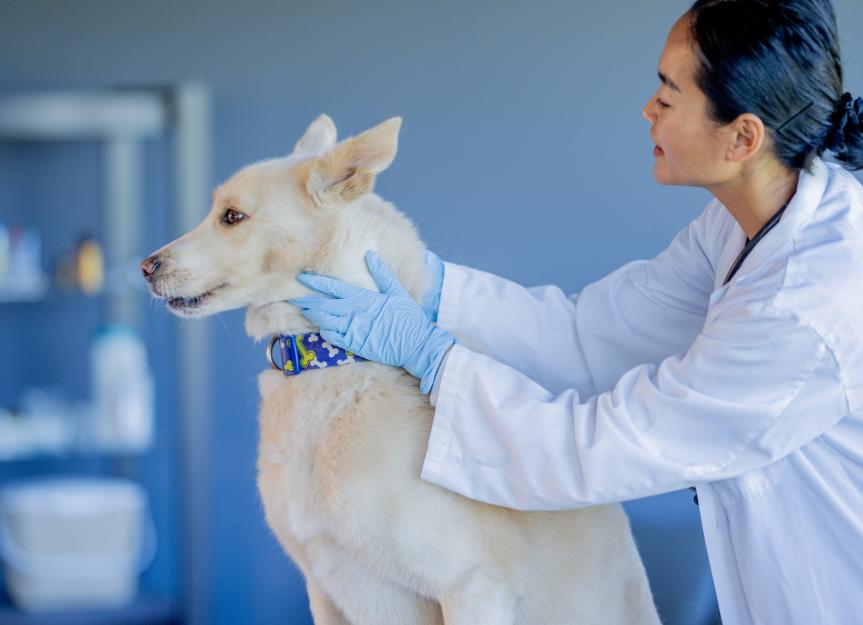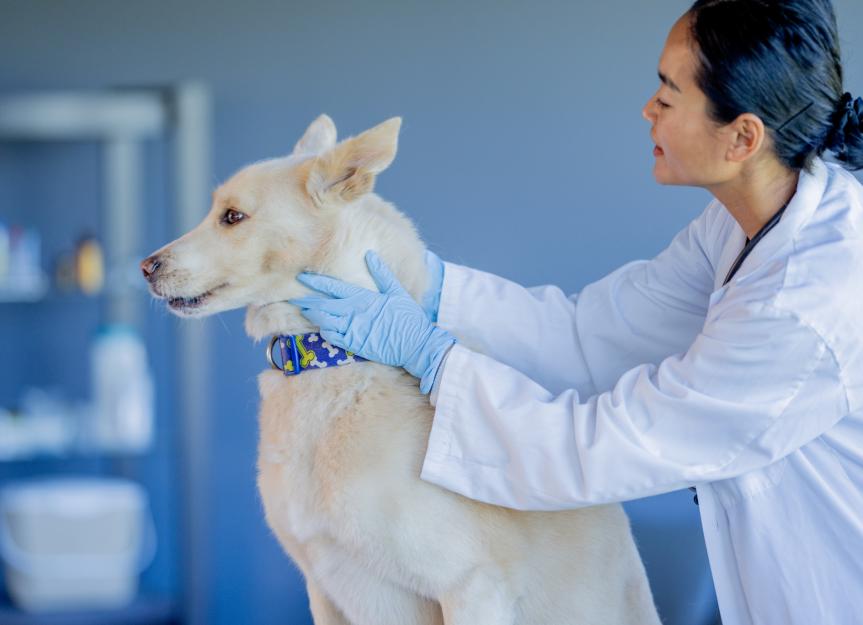
MRSA stands for methicillin-resistant Staphylococcus aureus.
It’s a type of bacteria that can be challenging to treat in dogs. Most bacterial infections are treated with antibiotics. But methicillin-resistant Staphylococcus aureus in dogs is a bacterial infection that can survive treatment with several commonly prescribed antibiotics.
While some may have heard of MRSA in people, many don’t realize that MRSA can spread from people to pets and vice versa.
Key Takeaways
- MRSA stands for methicillin-resistant Staphylococcus aureus, which is a strain of bacteria that can be challenging to treat in dogs.
- Most dogs with MRSA will survive and be successfully treated.
- There is not one specific antibiotic that will work on all MRSA in dogs. The right antibiotic varies depending on results from a skin culture and sensitivity test.
What Is Methicillin-Resistant Staphylococcus Aureus in Dogs?
Skin infections with Staphylococcus, or staph for short, are very common in dogs. These infections are usually easy to treat with beta-lactam medications like the methicillin-type antibiotics.
With methicillin-resistant S. aureus infections, however, none of these classic skin antibiotics work.
Fortunately, MRSA in dogs is rare. MRSA is much more common in people. Dogs more commonly get methicillin-resistant S. pseudintermedius (MRSP), which is a similar germ. It’s also difficult to kill with antibiotics.
When dogs have MRSA, they may not show signs of illness. Their immune system may readily clear the bacteria without any issues. Dogs that carry the bacteria on their skin without any symptoms of infection are referred to as “colonized.”
Pets who become sick from MRSA are usually those who are immunocompromised, meaning they are either very young, very old, or have underlying disease, wounds, or a recent surgery. Dogs that are symptomatic for MRSA may have slow healing or non-healing wounds that are swollen and infected.
While most skin infections should be treated quickly, they are not considered emergencies. Affected pets can be seen during business hours with their regular veterinarian.
Exceptions to this would be pets with signs of sepsis. Your pet could be septic if they are lethargic, not eating, feverish, or weak. These pets should be seen immediately.
Symptoms of Methicillin-Resistant Staphylococcus Aureus in Dogs
Symptoms of methicillin-resistant Staphylococcus aureus in dogs include:
-
Pus-like drainage from a wound.
-
Redness, heat, or swelling around a wound.
-
Delayed healing or non-healing wounds.
-
A wound that is not improving on antibiotics.
-
Ear, urinary, or joint infection not getting better with antibiotics.
Causes of Methicillin-Resistant Staphylococcus Aureus in Dogs
MRSA is much more common in people than in dogs.
Because of this, pets that are living in homes with MRSA-affected individuals are at the highest risk of catching MRSA. Pets visiting hospitals or nursing homes may also be at an increased risk of getting MRSA.
Pets who become sick from MRSA are usually those who are immunocompromised, meaning they are either very young, very old, or have underlying disease, wounds, or a recent surgery.
Pets that are immunosuppressed are at a higher risk of catching MRSA. Immunosuppression can be the result of underlying medical conditions (like immune-mediated disease and steroid use, or cancer). Pets who have open wounds or who have undergone recent surgery may also be at increased risk.
Inappropriate antibiotic use may also lead to MRSA infections. Inappropriate use of antibiotics happens when pets are started on antibiotics that aren’t prescribed specifically for them or are unnecessary.
Good antibiotic stewardship is important for decreasing antibiotic-resistant bacteria.
How Veterinarians Diagnose Methicillin-Resistant Staphylococcus Aureus in Dogs
Your veterinarian may suspect methicillin-resistant S. aureus in dogs that are not responding as expected to treatment. If your dog has a wound that did not clear up with the prescribed antibiotic, your vet will likely recommend more testing.
-
A skin culture and sensitivity test is the best way to diagnose MRSA. To do a culture and sensitivity, a swab will be used to collect bacteria from the surface of your dog’s wound. The swab will be sent to a lab, where it will be placed on a petri dish to see what type of bacteria grows.
-
After the lab has identified the type of bacteria, small antibiotic discs will be placed on the petri dish. This allows the pathologist to see which antibiotic works the best to kill that specific type of bacteria.
-
Before a skin culture and sensitivity test, your veterinarian may ask that you stop the original antibiotics. The duration of this pause will vary depending on the instructions of the laboratory that is being used.
-
-
A skin biopsy may be recommended. While delayed healing or non-healing wounds can be caused by antibiotic-resistant infections, they can also be slow to heal because of immune-mediated skin disease or skin cancer affecting your pet’s healing abilities.
-
To do a skin biopsy, your veterinarian will likely sedate your pet and use a local anesthetic (like lidocaine) to numb the region of skin. A small piece of skin will be surgically removed and sent to a laboratory for biopsy.
-
-
Blood work and a urinalysis are often recommended in patients who have delayed wound healing. Sometimes delayed healing is caused by an underlying medical condition, like an endocrine disease.
Treatment of Methicillin-Resistant Staphylococcus Aureus in Dogs
MRSA in dogs is treated with antibiotics different fromthose typically prescribed for standard skin infections. Treatment will likely involve a combination of both systemic and topical antibiotics.
Treatment is guided by culture and sensitivity results. Topical creams like mupirocin or oral antibiotics like clindamycin, sulfamethoxazole trimethoprim, or marbofloxacin may be prescribed.
MRSA is zoonotic, which means it can transfer between animals and people both ways. So, it’s important that it be treated correctly to keep all members of the household safe.
Your vet will likely recommend that you bathe your dog at least three days a week with a medicated shampoo that has chlorhexidine, like KetoChlor.
Once the right antibiotic is prescribed, MRSA should start to clear up quickly.
The duration of this time may vary depending on your dog’s health before getting the infection and how well they tolerate the selected antibiotic(s).
Recovery and Management of Methicillin-Resistant Staphylococcus Aureus in Dogs
Once the right antibiotic is found that can remove MRSA from your dog’s skin, recovery may take two to three weeks of systemic antibiotic therapy.
Most healthy dogs with no other medical conditions and a strain of MRSA that is not resistant to other antibiotics should clear up within 10–14 days.
However, medicated bathing will likely be recommended for several more weeks to months to prevent reinfection. Your vet may recommend repeat culture of the skin to make sure that the treatment course worked and no additional therapy is needed.
If your dog has underlying health conditions or is very old or young, they may need longer systemic treatment courses.
Sometimes, dogs may get a “superbug” that is resistant to multiple drugs. These superbugs are not only resistant to methicillin-type antibiotics, but also to other classes of antibiotics. These cases can take combinations of multiple antibiotics and very long courses to clear the infection.
If your dog is prescribed a “big gun” antibiotic (one that’s broad and powerful), additional checkups and lab work may be needed to see if their body is tolerating it. Sometimes, certain antibiotics do not agree with an individual dog.
If your dog gets any side effects from the new antibiotic, let your vet know right away. The most common side effects of antibiotics are diarrhea and vomiting. Probiotics, like Nutramax Proviable or Purina FortiFlora, may help your dog’s gut health while on antibiotics.
Prevention of Methicillin-Resistant Staphylococcus Aureus in Dogs
Limiting exposure to MRSA-affected individuals is the best way to prevent methicillin-resistant S. aureus in dogs. If you or someone else in your household have MRSA, limit interaction with your pet.
If your pet travels to a hospital or long-term care facility, where MRSA bacteria can be more prevalent, bathe them immediately after getting home with an antibacterial shampoo. This should kill any bacteria that may be on their coat.
Keep puppies and advanced senior dogs close to home and try to avoid unnecessary exposure to bacteria and viruses.
These pets should ideally not be taken to places where infectious diseases are more common.
Methicillin-Resistant Staphylococcus Aureus in Dogs FAQs
Can dogs survive MRSA?
Yes, most dogs with MRSA will survive and be successfully treated.
What does MRSA in dogs look like?
MRSA in symptomatic dogs looks like a skin infection that is not healing with antibiotics.
How long does MRSA take to heal in dogs?
MRSA can heal quickly in dogs after the right antibiotics are prescribed. These antibiotics are different from the type of antibiotics that are most often prescribed for common skin infections.
What antibiotic kills MRSA in dogs?
There is not one specific antibiotic that will work on all MRSA in dogs. The right antibiotic varies depending on results from a skin culture and sensitivity test.
Rifampin, clindamycin, sulfa trimethoprim, marbofloxacin, vancomycin, amikacin, chloramphenicol, and doxycycline are all examples of systemic antibiotics that may be prescribed based on culture results.



